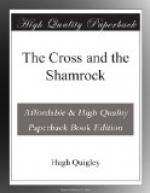“Is not this prejudice unreasonable and strange?” it will be asked. “And why is it that the Irishman shuns and abhors an institution which his English neighbor enjoys and petitions to enter?” The reasons are numerous, and the difference in the feelings of both obvious and palpable. It must be first remarked, that the Irish are a traditional people, and remarkably conservative of the customs and usages of their ancestors. They look back into the history of their country, or consult their fathers and grandfathers, and in vain look back for the existence of a poorhouse, or any necessity for its existence, before the advent of the “godly reformation” and the established church in their midst. They heard of such establishments as the ancient “beataghs,” or houses of hospitality, which were provided for the stranger and destitute in every townland, the doors of which were open day and night, and on the boards of which cooked victuals for scores of men were continually ready. These were the substitute for the poorhouse in the days when England and all Europe sent their poor scholars to receive a gratuitous education among the inhabitants of the Island of Saints. There the poor and the hungry could come in and eat, and be filled, and go his way, without being questioned who he was, without being asked for a pauper ticket to admit him, without being obliged or compelled to lead a life of celibacy, or running the risk of his soul’s salvation, to keep his body from perishing of hunger.
In a word, when Brian Boru expelled the Danes from Ireland, when Hugh O’Niel triumphed over the troops of Elizabeth, as well as when Dathi held the sceptre, or Nial of the hostages planted his colors on the Alps, there was enough to feed the poor of Ireland. There was no necessity for a poorhouse; and there is no need of it now, says the Irish peasant, if justice was done to Ireland. “Give us back our monasteries and abbeys, and we will bestow you the poorhouses.”
Besides these considerations, the English poorhouse has this advantage over the Irish one—that the former is conducted and presided over by Englishmen, who have a sympathy for, or at least are of, the same blood, religion, and race with its inmates. But in Ireland the case is different. The poorhouses, prison-like edifices, in Elizabethan style of architecture, presided over by Englishmen, generally, and nominees of the crown, are a monument of conquest and tyranny.
The inmates being principally “mere Irish,” and the cost of their support derived chiefly from the land, the landlords consider their health, comfort, or life of only secondary importance. Hence we find the number of deaths in these charnel houses averaging that of years of plague; and each pauper is allowed far less weekly for his support than the lord of the soil allows the meanest dog in his kennel. Add to these the separation of man and wife, the isolation of members of the same family, the dangers of perversion




